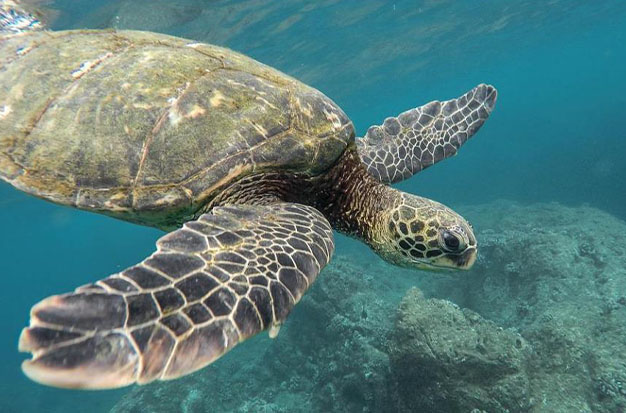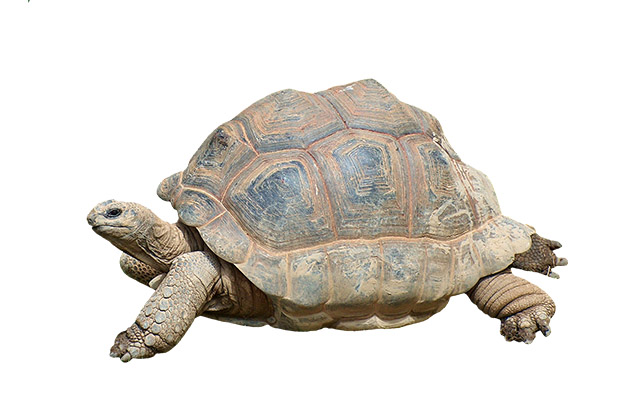Can Tortoises Swim? No!
Can tortoises swim underwater then? How do turtles and tortoises differ from one another? My tortoise, does it need water? We are going to cover all of these crucial issues in order to help you keep your shelled friend secure and content.
Do Tortoises Swim?
Swimming is not a skill that most tortoise species possess. This is so they could not swim, as they lacked certain streamlined body parts.
Most tortoises are exclusively land-based reptiles. They may splash around in small puddles and like to soak up the water, but they have no ability to swim or tread water. Most can’t even float.
The leopard tortoise, however, has the ability to float and swim gently. This allows it to slowly paddle its legs. Although the leopard tortoise moves very slowly in the water and this is not an efficient technique, it is still referred to as swimming.
This species of tortoise also has the ability to hold its breath. This enables them to stay submerged for extended periods of time before walking out of any deeper puddles or paddling slowly in pools. Up to 10 minutes can pass while the leopard tortoise is submerged in water.
Do Tortoises Have Aquatic Respiration?
As they lack gills, turtles are unable to breathe underwater. They can, at most, hold their breath, though some species are better at it than others.
Carbon dioxide is not toxic to turtles. This is so that tortoises can breathe normally before diving into their shells to hide. Therefore, when a tortoise is startled and tries to tuck itself away, you will frequently hear it exhale.
The leopard tortoise has a ten-minute breath-holding capacity. Numerous tortoises have been protected by this skill, enabling them to spend more time snug in their shells.
If leopard tortoises become submerged and start to float in the water, it has also made it easier for them to survive as they try to swim to land. Tortoises that were mistaken for turtles and abandoned to drown in the water are also protected.
Do Turtles Enjoy Swimming?
The majority of wild tortoises don’t like to swim and generally stay out of the water. They do this because they are aware that their bodies are not designed for swimming. They won’t be able to stay afloat and return to land. That might endanger lives. But tortoises do like to take baths and soak in shallow water. They can splash around and play in small pools as long as they can walk out.
Warm tub soaks are especially enjoyable for domesticated tortoises. They enjoy tottering around and briefly submerging their heads. However, you must never leave your pet tortoise unattended near water, even for a brief period of time. All it needs to do to drown is that.
Why Do Turtles Swim But Not Turtles?
Reptiles with remarkably similar looks to turtles include tortoises. Many people mistakenly use “tortoise” and “turtle” interchangeably because they think the terms are semantically related.
This is true to some extent given that both turtles and tortoises are members of the testudine family. However, in actuality, turtles and tortoises are two different species with distinct physiologies.
A tortoise is destined to live its entire life on land, while a turtle has evolved to spend the majority of its time in the water. Because it lacks the specific body parts of a turtle, a tortoise cannot learn to spend more time in the water or to swim.
Tortoises would have no reason to adapt since the two species also inhabit radically dissimilar habitats.
Turtles Vs. Tortoises
Since it really just refers to any member of their taxonomic family that has a mollusk-like shell and lays eggs, the term “turtle” actually refers to tortoises, terrapins, and sea turtles.
Tortoises and turtles, however, clearly differ in that sea turtles spend the majority of their lives in the water while tortoises live on land. When you examine them more closely, you can begin to understand why tortoises are better adapted to life on land and why turtles can swim.

Flippers Vs. Feet
The feet of sea turtles are actually more resembling flippers, as can be seen if you look at them closely. Turtles’ feet are made to be able to propel them through the water, which is very useful since they spend the majority of their lives in the ocean even though they come onto the beach to make their nests and lay eggs. Aquatic turtles, like terrapins, have webbed feet, but they differ slightly from terrapins’ webbed feet in that they also have claws that help them move easily on land and in the water.
Tortoise feet, on the other hand, resemble elephant feet more; they have clawed toes and bent legs that enable them to walk on land. Tortoises need something a little more robust to help them along because they can survive in a variety of environments as opposed to turtles who are restricted in their choice of habitat. Their feet may have claws that help them dig their burrows, but swimming would not be a good use for them.
Shells
Because of the shape of its shell and overall weight, tortoises are kept on land. In order to move through water with ease, turtles have a thin, flat, and streamlined shell.
A tortoise, in contrast, has a thick, dome-shaped shell with bony exterior plates called scutes. New scutes develop from beneath the older ones as the tortoise grows.
Scutes do come off in thin layers in tortoises, though. As a result, as they age, their shells become heavier and grow higher. As a result, larger species of tortoise appear bulky when fully grown.
This weight contributes in part to the slowness of turtles. For this reason, a large Galapagos tortoise will always move more slowly than, say, a small Egyptian tortoise.
Even just moving around on land can be challenging for these reptiles due to their bulky shells. A heavy tortoise would be much more likely to sink and drown than to stay afloat if it attempted to swim.
Habitats
The environments in which turtles and tortoises live are very different. As a result, each creature made the best possible adaptation to fit its environment. The impressive characteristics that allow tortoises to thrive in their habitats would be lost if they were able to swim.
The desert tortoise is an arid-area resident dry-land reptile, according to the University of Arizona. Water is in short supply, and it lives almost its entire life in sand and dirt. As a result, it has created a strong digestive system that extracts as much water as it can from its food.
Its skin and scales are well adapted to ward off too much sun exposure and withstand the dry, sweltering temperatures. Its feet are well suited for moving over uneven ground and breaking through hard soil.
Because they don’t need to be, none of these characteristics are particularly suited to swimming or living in water. Therefore, the desert tortoise is unable to swim. It hardly ever has the opportunity to.
Turtles are adapted to aquatic environments because they spend almost their entire lives there. They are hydrodynamic due to their webbed feet and shells, as well as their ability to hold their breath for long periods of time.
Tortoises have changed over time to fit their surroundings. Even those who live in more humid, swampy climates don’t swim because they still stay on land.
Are Tortoises Waterproof?
There are conflicting reports regarding whether or not turtles can float, so we don’t want to encourage anyone to go out and try to find out on their own! It is claimed that it depends on a number of variables, including the species, age, and size of the tortoise.
In our opinion, it’s better to play it safe and keep your tortoise out of deep water because the risk isn’t worth it. It will probably stress your tortoise out and put them in serious danger of drowning, regardless of whether they can float or not.
Can Young Turtles Swim?
Neither domesticated nor wild baby tortoises can swim. Despite this, they are still found close to bodies of water like their adult counterparts.
That’s because, like all animals, they require water to drink and bathe. They would probably drown and pass away if you accidentally dropped them in water or if you threw them into it.
A tortoise can hold its breath for a long time, as was previously mentioned. However, young tortoises have small lungs because they aren’t very large.
Due to its light weight, it would have a higher chance of floating, but it would also have a higher chance of perishing when it submerged. Even more so than an adult, a lack of strength would prevent it from paddling to shore.
Conclusion
We hope that answers all of your questions about whether or not turtles can swim. To sum up, turtles and tortoises are two different species of animals that have evolved to live in various habitats. As opposed to tortoises, which are land animals and cannot swim, turtles can swim incredibly well despite living in the ocean.
Despite this, it doesn’t mean that your pet tortoise won’t occasionally enjoy soaking in their water bowl or that you can’t give them a quick bath.
Just keep in mind to never endanger your tortoise and abide by our recommendations for a contented and secure tortoise! Does your tortoise enjoy taking baths? Please tell us in the comments!
Just keep in mind to never endanger your tortoise and abide by our recommendations for a contented and secure tortoise! Does your tortoise enjoy taking baths? Please tell us in the comments!
Read more about: Can Cows Swim? Yes! Can Rats Swim? Everything You Need To Know Can Horses Swim? Everything You Should Know About Horses And Swimming
